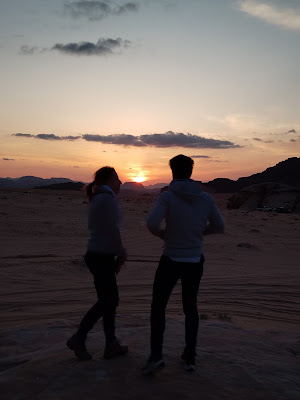Wadi Rum desert
What is Wadi Rum?
Wadi Rum desert It is also known as the Valley of the Moon
It is a valley carved in sandstone and granite rocks in southern Jordan, near the border with Saudi Arabia and about 60 km (37 mi) east of the city of Aqaba.
It has an area of 720 km2 (280 sq mi) and is the largest valley in Jordan.
The Wadi Rum desert begins immediately after the village of Wadi Rum, heading southeast, all the way to the Saudi border
Many prehistoric civilizations left petroglyphs, rock writings, and monuments in Wadi Rum.
Today it is a tourist attraction.
Visitors come to it from all over the world.
Guided tours, hiking and rock climbing are available.
and camping in Bedouin camps or in caves under the stars
Wadi Rum Reserve has been a UNESCO World Heritage Site since 2011.
What is the origin of the name Wadi Rum and its meaning?
The name Wadi Rum or Wadi Rum is believed to derive from the ancient name of Iram of the Pillars (also called Irum (Arabic: اْرَم)), a lost city mentioned in the Qur'an.
Also, the word (wadi) means the passage between the two mountains, and it is a low area.
And the word (rum) means high mountain peaks
History of Wadi Rum
In the distant past, in the late Ice Age period,
(10,000 years ago) Field research shows in the Wadi Rum area
The presence of population centers, where the area was densely wooded and received large amounts of rain,
Its appearance at that time was very far from its current desert nature. And the presence of large quantities of groundwater in this region, is due to the intensity of rain in that period of history.
It is believed that the first person to document Wadi Rum in history was the Roman geographer Ptolemy in his book (Geography) and mentioned it as 'Aramaua'
The inscriptions are found in all parts of the Wadi Rum desert
These rock inscriptions and drawings represent 12,000 years of human presence in the Wadi Rum desert. It tells stories about the history and stages of human life development in the Arabian Peninsula.
The Wadi Rum desert is one of the few distinct regions in the world, as it contains 25,000 carved images and more than 20,000 inscriptions, most of which are Thamudic.
Wadi Rum has been inhabited by many human cultures since prehistoric times, with many cultures, including the Nabataeans, leaving their mark in the form of rock carvings, stone buildings, and temples.
Tourism in WadiRum
Lawrence of Arabia's desert scenes of Wadi Rum began in 1962 as the beginning of Jordan's tourism industry.
The Wadi Rum desert is one of the most popular tourist sites in Jordan and attracts an average of 15,000 tourists every month from all over the world.
Wadi Rum is home to the Zalabiya tribe, who have developed eco-adventure tourism and services throughout the protected area. They provide tours, guides, accommodations and facilities. They also run restaurants and small shops in the villages that provide meals and basic necessities to visitors. Their guide services include highly experienced mountain and trekking guides who have unparalleled knowledge of the local area
They are often fluent in two or more languages. The use of local guides and services brings many benefits to the protected area. In particular, it enables people to continue to make a living off the land and helps ensure that the protected area remains protected.
Popular activities in the desert environment include 4WD tours, camel rides, camping under the stars, Arabian horseback riding, hiking, and rock climbing among the massive rock formations. Travelers staying in the area can spend the night in Bedouin-style camps, located in the desert, or luxury hotels. Hikers and adventurous travelers may also choose to camp outdoors, under the stars. Tour operators offering this experience provide sleeping equipment, meals, and transportation.








